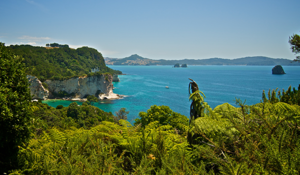
Photo Credit: Macronix – CC BY 2.0
Whitianga is short for Te Whitianga-o-Kupe (Kupe’s crossing place). In Māori tradition, Kupe was an early explorer who visited Aotearoa. The bay which Whitianga sits on was called Te Whanganui-o-Hei (Hei’s great bay), after a tupuna from the Te Arawa canoe who had settled at the bay.
In 1769, Cook entered the harbour to observe the transit of Mercury. One of Cook’s biographers, JC Beaglehole, theorised that originally Cook was not going to give the bay a European name. In his journal, Cook explained that the ‘natives’ had many names for parts of the bay, but he had chosen just one of these for the whole bay – and then he left a gap, presumably meaning to write it in later. Beaglehole further argues that he would probably have used the name ‘Opoorage’, which naturalist Joseph Banks noted down.
But Cook never filled in the gap. Instead he called it Mercury Bay.
When a European settlement was established, it used the shortened name Whitianga. During the 1920s, the town became a holiday destination for sports fishermen and motor tourists, but tourism operators promoted the town as ‘Mercury Bay’ not Whitianga. Telegrams and post were reportedly delayed or lost due to the confusion. There was a campaign to change the name of the post office, but in 1928 the Honorary Geographic Board of New Zealand (the Board) refused, because of the tensions in the district.
The debate continued in the letters to the editor. Supporters argued that ‘Whitianga’ stood in the way of progress and those in support of the ‘old’ name were conservatives, anti-business and living in the past. They stressed the connection with Cook.
On the other side of the argument, local resident Alfred Lee explained that ‘Mercury Bay’ was the body of water, while ‘Whitianga’ was the town – both names would be kept. If there was any confusion, Lee said, it was the fault of those who had been advertising the town under the wrong name. Against the charge that Kupe was a myth, another correspondent said: ‘Kupe and Hei (like Cook) were indeed historical personages – all of them great navigators in that chronological sequence, not mere members of a mythical pantheon’.
A Māori correspondent remarked:
As a representative of the Maori people, still large and interested landowners in those places, we decidedly disapprove of the abandonment of the name Whitianga. Such historic place-names mean much to us…They remain as monuments, as it were, of the past times of our Maori people, which we desire to be perpetuated for all time.
In 1928, the matter came before the Coromandel County Council three times. A survey showing 116 in support of and 15 against Mercury Bay was presented, but was found to have been poorly conducted. A councillor then presented a petition from 126 residents in favour of retaining Whitianga. The council voted six to three to keep the name ‘Whitianga’.
Seven months later, the Board, unaware of the council’s decision or that the first poll was inaccurate, decided to change the name of the post office to Mercury Bay. But no one in Whitianga seemed to know. The town was still referred to as ‘Whitianga’ in newspaper articles and advertisements, side-by-side with advertisements for Mercury Bay fishing. Everything seemed settled.
In the 1930s, Lee discovered the change has been made via a New Zealand Herald article. He penned a long letter to the Board. In 1936, after further letters from Lee, the Surveyor-General assured him that the Board’s decision on the Post Office name was never acted upon and the name never actually changed. The decision was rescinded.
Lee continued to campaign throughout the 1930s and 1940s for the name be used. Lee’s fears weren’t unfounded; in 1951 and throughout the 1970s, RA Simpson wrote to the Board several times asking it to change the town’s name to ‘Mercury Bay’. Each time he was politely told the matter had been dealt with previously. Two members of Lee’s family, aware of Simpson’s letters, wrote to the Board. One concluded: ‘A great deal of bitterness was engendered in the late 1920s and early 1930s when Mr. Simpson’s brother tried to have the name changed. We most certainly do not need that sort of thing again.’ Rather fittingly, this is a last piece of correspondence on the matter from the public.
References
- NZ Gazetteer - Mercury Bay
- NZ Gazetteer - Whitianga
- Paul Monin, 'Hauraki–Coromandel places - Mercury Bay', Te Ara - the Encyclopedia of New Zealand
- JC Beaglehole (ed), The journals of Captain James Cook on his voyages of discovery, Vol. 1, Hakluyt Society, Cambridge (England), 1955, p. 202NZGB, Correspondence, 9 July 1928, Vol. 5, p. 93
- NZGB, Correspondence, Vol. 5, 11 July 1928, p. 101.
- TH Lyon, ‘Mercury Bay or Whitianga’, New Zealand Herald, 11 January 1929, p. 12
- TH Lyon, ‘Mercury Bay or Whitianga’, New Zealand Herald, 28 January 1929, p. 12
- 'Controversy over name', New Zealand Herald, 3 January 1929, p. 6
- George Graham, ‘Mercury Bay or Whitianga’, New Zealand Herald, 15 February 1929, p. 14
- Temetete, ‘Mercury Bay or Whitianga’, New Zealand Herald, 28 February 1929, p. 14
- ‘Whitianga or, Mercury Bay’, Coromandel County News, 23 November 1928, page unknown.
- NZGB, Minutes, 11 June 1929, p. 3
- NZGB Correspondence, 5 May 1934, Vol. 11, p. 23
- NZGB, Correspondence, 9 June 1936, Vol. 12, p. 48
- NZGB, Minutes, 7 July 1934, p. 4
- NZGB Correspondence, 5 July 1951, Vol. 26, p. 273-1-273-3
- NZGB Correspondence, 22 May 1975, Vol. 43, pp. 83-84
- NZGB Correspondence, 4 August 1975, Vol. 43, pp. 117-118
- NZGB Correspondence, 18 December 1975, Vol 43, p. 197
- NZGB Correspondence, 12 January 1976 Vol. 43, p. 198
- NZGB, Correspondence, 25 April 1976, Vol. 43, p. 240